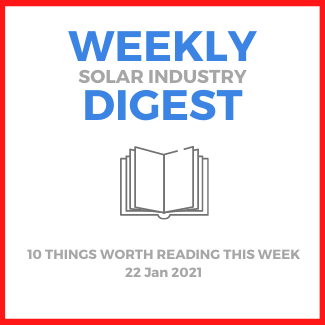Solar in the Northeast is steadily growing, particularly ground-mount, and it’s hitting into the area’s compacted and rocky soil conditions, high wind speeds and frost and snow. This calls for “a higher level of engineering and expertise” to make these installs successful.
A new leap in tech for bifacial panels, the engineered reflective albedo, is being tested on single-mast dual-axis arrays. It allows for a further double-digit boost in gain, particularly for groundmount systems on sloped, irregular, or confined land footprints.
Biden has appointed Democrat Richard Glick chair of FERC. Glick opposes the minimum offer price rule, the refusal to change to NYISO’s buyer-side mitigation rules that restrict competitiveness for renewables, and the approval of capacity and fuel security market designs by ISO New England.
Report states that solar is on track to become the cheapest source for power in every US state and 16 other nations in 9 years (it already is in 16 states and 3 counties). It predicts that cost for solar will drop 15-25% more over that time period, in keeping with the 90% drop over the last 20 years.
This is a roundup of mistakes your prospect makes when considering solar system design. It provides insights into their mind frame when you step through the sales and design process. Includes confusing off-grid and grid-tie solar, not knowing about system sizing variables and thinking leasing is great.
With growing state requirements for module-level rapid shutdown, there are now multiple options with various features. APsmart is compatible with any string inverter brand plus bifacial while ZERUN’s solution can be mounted on the module frame or backsheet.
The U.S. Court of Appeals for the D.C. Circuit struck down the Trump administration’s “Affordable Clean Energy” rule. They sent it back to the EPA for reconsideration as “a mistaken reading of the Clean Air Act” stating that the EPA “misconceived” the law.
Top factors for you and your customer to consider when permitting: rules for a particular geographic location (includes residential and suburban vs. rural), planning for wind & snow loading, specific engineering requirements, and new and/or complex equipment.
Hawaii’s utility commissions issued a performance-based regulation order that could serve as a possible template for the transformation of the US power system. Hawaiian Electric will be the first investor-owned utility to move away from the cost of service regulation to performance-based regulation.
Two UCLA professors assert that a balance must be struck among all the solutions for the energy crisis, one that “trades off between the benefits of economic growth and the costs of environmental damage.” This means including fossil fuels and carbon taxes in the solution.

